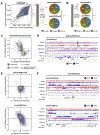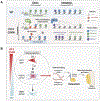H3.3 G34W Promotes Growth and Impedes Differentiation of Osteoblast-Like Mesenchymal Progenitors in Giant Cell Tumor of Bone
- PMID: 32967858
- PMCID: PMC7710565
- DOI: 10.1158/2159-8290.CD-20-0461
H3.3 G34W Promotes Growth and Impedes Differentiation of Osteoblast-Like Mesenchymal Progenitors in Giant Cell Tumor of Bone
Abstract
Glycine 34-to-tryptophan (G34W) substitutions in H3.3 arise in approximately 90% of giant cell tumor of bone (GCT). Here, we show H3.3 G34W is necessary for tumor formation. By profiling the epigenome, transcriptome, and secreted proteome of patient samples and tumor-derived cells CRISPR-Cas9-edited for H3.3 G34W, we show that H3.3K36me3 loss on mutant H3.3 alters the deposition of the repressive H3K27me3 mark from intergenic to genic regions, beyond areas of H3.3 deposition. This promotes redistribution of other chromatin marks and aberrant transcription, altering cell fate in mesenchymal progenitors and hindering differentiation. Single-cell transcriptomics reveals that H3.3 G34W stromal cells recapitulate a neoplastic trajectory from a SPP1+ osteoblast-like progenitor population toward an ACTA2+ myofibroblast-like population, which secretes extracellular matrix ligands predicted to recruit and activate osteoclasts. Our findings suggest that H3.3 G34W leads to GCT by sustaining a transformed state in osteoblast-like progenitors, which promotes neoplastic growth, pathologic recruitment of giant osteoclasts, and bone destruction. SIGNIFICANCE: This study shows that H3.3 G34W drives GCT tumorigenesis through aberrant epigenetic remodeling, altering differentiation trajectories in mesenchymal progenitors. H3.3 G34W promotes in neoplastic stromal cells an osteoblast-like progenitor state that enables undue interactions with the tumor microenvironment, driving GCT pathogenesis. These epigenetic changes may be amenable to therapeutic targeting in GCT.See related commentary by Licht, p. 1794.This article is highlighted in the In This Issue feature, p. 1775.
©2020 American Association for Cancer Research.
Conflict of interest statement
Figures







Comment in
-
Histone H3 G34 Tail Mutations in Cancer: Actions in Cis and Trans to Alter Chromatin and Gene Expression.Cancer Discov. 2020 Dec;10(12):1794-1796. doi: 10.1158/2159-8290.CD-20-1396. Cancer Discov. 2020. PMID: 33262183
References
-
- Board WC of TE. Soft Tissue and Bone Tumours WHO classification of tumours. 2020; 5th edition, 3.
-
- Schwartzentruber J, Korshunov A, Liu X-Y, Jones DTW, Pfaff E, Jacob K, et al. Driver mutations in histone H3.3 and chromatin remodelling genes in paediatric glioblastoma Nature. Nature Publishing Group; 2012;482:226–31. - PubMed
Publication types
MeSH terms
Grants and funding
LinkOut - more resources
Full Text Sources
Medical
Molecular Biology Databases
Research Materials
Miscellaneous

